LOSS OF LANCASTER
JB 607, AR-N, "LEADER"
460 SQUADRON RAAF
ON 29 DECEMBER 1943
![]()
Lancaster III bomber JB-607 (AR-N) ‘Leader’, of 460 Squadron RAAF, left Binbrook Airfield at 17.03 hrs to bomb Berlin, in Germany. They were part of a group of 712 bombers that day (22 were RAAF aircraft). 1200 4-pounder firebombs, 56 30-pounder firebombs and a cookie of 4,000-pound were to be delivered. They flew in the first wave of five aircraft over the target.
The Lancaster was shot down at 22.30 hrs by a German night fighter on its return flight, on 29 December 1943. Six of the seven crew members were killed. The Bomb Aimer, F/Sgt. Frank J. Seery bailed out and survived the remainder of the war as a POW in Stalag IVD near Torgau on the Elbe.
Those killed were as follows:-
P/O Stan J. Ireland
P/O Ambrose. E. Blight
F/Sgt Max H. Squires
Sgt William A.H. Squire
Sgt Cyril Seddon
Sgt Reg J. Poulter
They were at first buried in the Friars cemetery in Kerkrade. After the war they were all reburied in the Commonwealth War Graves Commission Cemetery at 'Reichswald' in Kleve (Germany). Stan Ireland, Ambrose Blight, Cyril Seddon, Reg Poulter and Billy Squire are buried at Coll. Grave 27. C. 1-12 at the CWGC-cemetery 'Reichswald' in Kleve (Germany). Max Squires is buried at Grave 15. A. 12. at the CWGC-cemetery 'Reichswald' in Kleve (Germany).
Frank Seery wrote to me on 23 February 2004 and described his recollections of this tragic loss of life as follows:-
In my understanding we crossed the German/Dutch frontier much further north than Aachen. Our prescribed track that night also coincided with my understanding.
The quiet of our night was rudely shattered by what appeared to be a single shot which hit the nose of our plane. Stan called out "It's a fighter", and dived the plane to port. While in that dive we were hit by a massive fusillade of shells.
Four of the crew were killed immediately, the four engines destroyed and the plane set ablaze. Somehow Stan righted the plane, which was now on a southerly course.
As I ditched the escape hatch, the slipstream caught and twisted it, jamming it in the hatch opening. My kicking of the hatch proved futile, until I got the Flight Engineer to join me. A couple of united kicks and the hatch flew out, followed rapidly by me, as the Flight Engineer raced back to collect the pilot.
Unfortunately, Stan and Bill didn't have a chance to follow me as the aircraft exploded a few seconds after my exit. It was a tragedy that but for the hold-up with the hatch, the three of us could possibly have escaped.
Our track home that night would not have taken us anywhere near Cologne or the Aachen area, but Stan's righting of the plane, after his dive to port, would have set us on the way. Stan's only concern, of course, was to hold the plane as steadily as he could until the three of us were able to escape from it.
When I landed in Holland my great hope was that Stan and Bill were blown clear in the explosion, but, unfortunately, they were both killed by it.
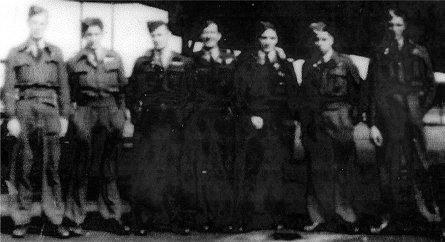
Crew
of Lancaster
III bomber JB-607 (AR-N) ‘Leader’
From left Seddon, Squires, Ireland, Blight, Seery, Poulter and Squire
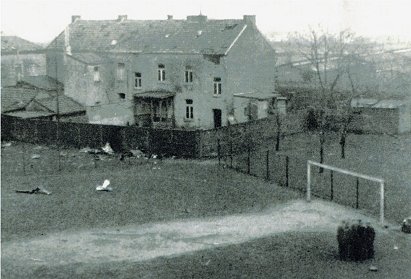
Photo: via Wim Slangen
Wreckage on the football
pitch belonging to the boarding school of the Friary
of the Friars of Saint Franciscus in Kerkrade/Bleijerheide.
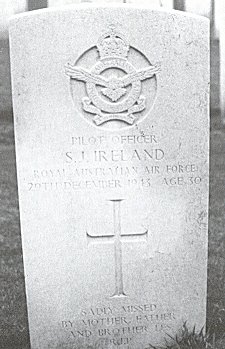
Photo: via Wim Slangen
Grave of Pilot Officer Stan Ireland at Reichswald
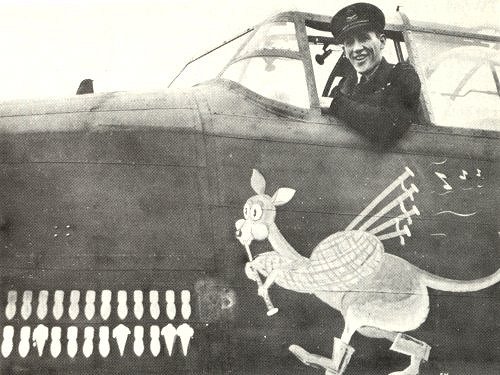
Photo: via Wim Slangen
Nose art on JB607 with Stan Ireland (?) in the cockpit
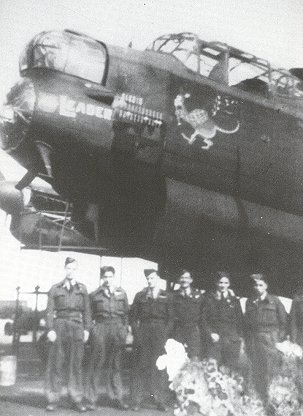
Photo: via Wim Slangen
Lancaster
III bomber JB-607 (AR-N) ‘Leader’ and its crew.
From left Seddon, Squires, Ireland, Blight, Seery, Poulter and Squire
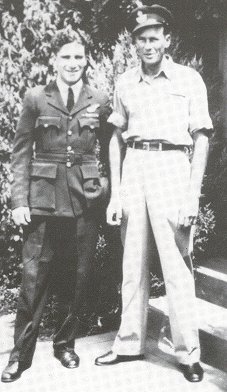
Photo: via Wim Slangen
Frank Seery with his brother-in-law at his parents' home in wartime Australia
Map of crash location shown
on a map; P 229
is a German-Dutch bordermarking. The road
on the left was a road within the middle the
German-Dutch border. "Klooster" is the "Friary"
Peter Heckmanns of Kerkrade, in The Netherlands, bought a house back in 1998, which is situated at the Nieuwstraat in Kerkrade, near the German border. Behind the house there is an impressive Monastery with two soccer pitches. Peter played soccer in his childhood on those pitches and heard a story about an Allied bomber that was shot down and was told that it should still be under the main pitch. After many years Peter learned that it was the Avro Lancaster B MK III JB 607 from the 460 Squadron RAAF, and that all the crew were killed that night except for one. Sgt Frank Seery survived and was reportedly betrayed by some of the people he was fighting for. Although that is what people think, Peter believes that as he was very near the German border, Frank could easily have walked into a house full of German people.
In his e-mail to me on 28 Dec 2003, Peter Heckmanns said:-
You don't know me and we never met, but the same happened to the crew of the Avro Lancaster B MK III JB 607 which was shot down by a German night fighter over Aachen on the 29th December 1943 and their opponent in the sky. I never met them but in the Netherlands and in the rest of the World we owe a lot to the men that flew those missions and even payed with there lives for our freedom.
I'm only 34 years old so I never was in a war, the reason I mailed you is that I bought a house back in 1998 a house which is situated at the Nieuwstraat in Kerkrade, near the German border. Behind the house there's a pretty impressive monastery with two soccer pitches. I played soccer in my childhood on those pitches and I heard of an Allied bomber that was shot down and it should still be under the main pitch. After many years I learned that it was the Avro Lancaster B MK III JB 607 from the 460th RAAF Squadron, all got killed that night but one ... Sgt Frank Seery survived and get betrayed by some of the people he was fighting for. Although that is what people think, fact however is that we are very near the German border so he could well have walked into a house full of German people I don't know.
By now you must be asking yourself, why is he telling me all this. The reason is that tomorrow it is 60 years that have past since 6 of those 7 heroes were killed over my house and in my backyard. With this mail I wish to pay my respects to them and to all the Australian soldiers and airman that died for our freedom. I will say a prayer for them and light a candle ... is it possible for you to sent me some more information on this crew ? For example where they are buried at the moment ? I'm grateful for every bit of info. I attached a file which I got from your "crewpage" so you know which crew I mean.
The following information was passed on to me by Bart Smeets from Holland. The information was produced by Mr Ed Melis, Chairman "National Committee Last Post 1940-1945" Netherlands.
Lancaster III bomber JB-607 (AR-N) ‘Leader’, 460th RAAF Squadron (Australian), Binbrook Airfield UK.
Bomb mission to Berlin, Germany, shot down by German night fighter on return flight, 29 December 1943.
|
Subject |
Details |
|
Frame |
World War II ‘European Theatre Of Operations (ETO)’ West Front 1943. |
|
Date |
29 December 1943. |
|
Time |
Around 22:30 hours, local time (Dutch time). |
|
Unit |
460th
RAAF Squadron (Royal Australian Air Force). Motto: “Strike and
Return”. |
|
Aircraft type |
Avro Lancaster III, British heavy bomber, four engines power. |
|
Aircraft markings |
Serial
number JB-607. Nickname ‘Leader’. |
|
Base |
Binbrook
Air Field, Lincolnshire England, 9 miles SW of Grimsby; |
|
Mission |
Bomb mission to Germany, by 712 RAF bomber aircraft. |
|
Target area |
Berlin, Germany (behind enemy lines). |
|
Crew |
7 crewmembers on board: Pilot, Navigator, Bomb Aimer, Gunner (Royal Australian Air Force), Flight Engineer, Wireless Operator / Gunner, Gunner (Royal Air Force Volunteer Reserve). |
|
Air route |
Take-off from Binbrook Airfield UK - Formation Point in UK - over the Channel - over Holland – Initial Point in Germany - bomb run to target area Berlin in Germany - and back. |
|
Incident |
29 December 1943, 460th take off from Binbrook at 17:03 hours Anglian Time, late afternoon. Squadron in formation pattern, along with more than 700 allied aircraft in direction Germany. The bombers succeeded in completing their mission over Berlin, and the city was set on fire. In the evening, the allied bomber formation was on return flight to England. Returning over Koeln (= Cologne), Lancaster bomber number JB-607 (code letters AR-N, with 7 crewmembers) was bounced by a German night fighter, which opened fire at around 22:00 hrs. Over German territory north of Aachen, in direction Holland, the bomber was hit a second time and set ablaze. Just over the German/Dutch border, the plane went down and crashed in the garden of a monastery in Bleijerheide near Kerkrade, Netherlands. Probably the pilot tried to avoid a crash on the buildings, looking for an emergency landing. Six crewmembers were killed, only the Bomb Aimer bailed out safely with his own parachute. Some remains of the six crewmembers were found by the residents and friars of the monastery. They were buried in the RC Churchyard of the Franciscan monastery in Bleijerheide, Kerkrade. The Bomb Aimer was taken POW by two German soldiers, and transferred to Stalag IV-D (near the Elbe river) Germany, where he was kept until the end of the war; he returned to Australia. The six crewmembers buried at the monastery, were reinterred for last interment, in the Reichswald Forest War Cemetery, Kleve, Germany. |
| Crash site | In the garden of the Franciscan monastery in Bleijerheide, near Kerkrade, Netherlands; south point of The Netherlands (near the Dutch-German border). |
|
Casualty list |
6 of 7 crewmembers were KIA; only the Bomb Aimer bailed out and survived as POW. |
|
Interments |
1.
remains buried near crash site by friars, at churchyard monastery
Bleijerheide, Netherlands. |
|
Note |
29
December 1943 – 29 December 2003: 60th remembrance of this
incident. |
|
Sources |
Netherlands:
Mr Rene Willems (reporter), newspaper ‘Limburgs Dagblad’ 27 December
2003; |
|
Contact |
Netherlands:
Franciscan monastery, Bleijerheide-Kerkrade; Mr Arnold Reusken (friar
Ignatius), Pannesheiderstraat 71, 6462EB Kerkrade; Municipality of Kerkrade,
website https://www.kerkrade.nl. |
Air crew
Crew members:
|
Rank |
Name |
Service # |
Regiment |
Nationality |
Age |
Crew position |
Status |
|
P/O |
S.J.
Ireland |
412010 |
RAAF |
Australia |
30 |
Pilot |
MIA
29 Dec 1943, |
|
P/O |
A.E.
Blight |
416114 |
RAAF |
Australia |
29 |
Navigator |
MIA
29 Dec 1943, |
|
F/Sgt |
F.J.
Seery |
413435 |
RAAF |
Australia |
22 |
Bomb Aimer |
MIA
29 Dec 1943, |
|
F/Sgt |
M.H.
Squires |
241518 |
RAAF |
Australia |
20 |
Gunner |
MIA
29 Dec 1943, |
|
Sgt |
W.A.H.
Squire |
1803573 |
RAF VR |
United |
19 |
Flight Engineer |
MIA
29 Dec 1943, |
|
Sgt |
C.
Seddon |
1534670 |
RAF VR |
United |
22 |
Wireless
Operator / |
MIA
29 Dec 1943, |
|
Sgt |
R.J.
Poulter |
1424279 |
RAF VR |
United |
21 |
Air Gunner |
MIA
29 Dec 1943, |
P/O = Pilot Officer, F/Sgt = Flight Sergeant, Sgt = Sergeant;
RAAF = Royal Australian Air Force, RAF VR = Royal Air Force Volunteer Reserve;
MIA = Missing In Action, KIA = Killed In Action, POW = Prisoner Of War, Rtd = Returned.
Interments:
|
Name |
Temporary Grave |
Last Interment |
|
Stanley
James |
RC
Churchyard |
Coll.
Grave 27/C/1-12 |
|
Ambrose
Edward |
RC
Churchyard |
Coll.
Grave 27/C/1-12 |
|
Frank
John |
Survived |
Returned
after the war |
|
Maxwell
Hope |
RC
Churchyard |
Grave
15/A/12 |
|
William
Albert Henry |
RC
Churchyard |
Coll.
Grave 27/C/1-12 |
|
Cyril |
RC
Churchyard |
Coll.
Grave 27/C/1-12 |
|
Reginald
James |
RC
Churchyard |
Coll.
Grave 27/C/1-12 |
Dutch newspaper article in local newspaper ‘Limburgs Dagblad’ Saturday 27 December 2003:-
Franciscan Friars of Monastery in Bleijerheide
remember crash of Lancaster bomber in WWII
Sixty years ago, a bomber of the Australian Air Force crashed in the garden of the Franciscan friars of Bleijerheide, in the Netherlands. Six of seven crewmembers lost their lives.
Kerkrade
By
Mr Rene Willems (reporter)
Friar Ignatius puts an old photograph on the table. A group of men – or boys – is watching the fragments of the Lancaster bomber, on the football field of the Franciscan monastery in Bleijerheide. It must have been a heavy smash: the pieces flew into the gardens of the houses in the Nieuwstraat of Bleijerheide village.
The bomber went down exactly between the monastery and the houses of the villagers. That is no coincidence, friar Ignatius says: “I always had the idea, that the crewmembers tried to avoid the buildings. They paid with their lives for that; if they had bailed out in time, they could have survived the incident.”
The bomber belonged to the 460th squadron of the Royal Australian Air Force. The squadron was committed to the second bombardment of the allied forces on Berlin, on 29 December 1943. In England, about 712 heavy bombers took off. After they had completed their mission in Germany – Berlin was set on fire – the planes returned home to England.
Over Cologne city, Lancaster number JB-607 nicknamed ‘Leader’, was bounced by a German nightfighter. Approaching Aachen city (Note - Frank Seery believes they were much further north than Aachen), the second volley firing of the nightfighter was fatal: the four-engined Lancaster was set ablaze. Bomb Aimer Frank Seery bailed out safely with his parachute. He was the only survivor; seconds later the ship exploded.
Next morning, Seery knocked on the door of an old farmhouse, where he met some Dutch hospitality.
“I felt like a lost son who rejoined his beloved family”, he explained later to historian Mr Ron Puetz in Kerkrade, Netherlands, who is the author of the book “Duel in the clouds” describing the air raids on Germany during World War II. But his stay on the farm was not for a long time. Half an hour later, two uniformed Germans entered to arrest him. He was transferred as a POW to the German permanent prison camp ‘Stalag IV-D’ on the Elbe river, where he was kept until the end of the war.
The friars of the Franciscan monastery took care of the remains of the six crewmembers: pilot Stan Ireland (age 30), navigator Ambrose Blight (29), Cyril Seddon (22), Reg Poulter (21), Max Squires (20) and Billy Squire (19). They were temporarily buried in the RC churchyard of the Franciscan monastery. After the war they were reinterred by the British in a Military Cemetery.
“We do not know until today, where their last interment exactly is”, friar Ignatius says. Five years ago the friars found a little note, a photograph and a cross of corn poppies in their churchyard. “In memory of Sgt. W.A.H. Squire and his 5 mates”, the message said. “Apparently, Mr Frank Seery was here, to remember his slain comrades” brother Ignatius suggested. “I would have been glad to get in touch with him, but he was already gone. Unfortunately I did not succeed in tracking down his current address in Sydney, Australia; otherwise we could have sent him a nice Christmas greeting”.
The friars built a little marker for the crew of the Lancaster, including pictures of Seery’s letter and a cross made of corn poppies. The letter and the cross are shown in the chapel of the monastery now.
“It is at the least we can do for these boys”, brother Ignatius stated. “If they would not have thought of us in those last seconds, the whole monastery would probably have been blown away.”
Photo 1: The wreck pieces of the Lancaster were scattered all over the field.
Photo 2: Frank Seery was the only survivor of seven fellow crewmembers.
The following information is from the Commonwealth War Graves web site:-
In Memory of
Sergeant WILLIAM ALBERT HENRY SQUIRE
1803573, 460 (R.A.A.F.) Sqdn, Royal Air Force
Volunteer Reserve
who died age 19, on
29 December 1943
Sergeant SQUIRE, Son of William Charles and
Charlotte Ethel Squire, of Tottenham, Middlesex.
Remembered with honour
REICHSWALD FOREST WAR CEMETERY
Coll. grave 27. C. 1-12.
In
Memory of
Pilot Officer STANLEY JAMES IRELAND
412010, Royal Australian Air Force
who died age 30,
on
29 December 1943
Pilot
Officer IRELAND, Son of Leslie Joseph and Stella Carrington Ireland, of
Glebe, New South Wales, Australia.
Remembered with honour
REICHSWALD FOREST WAR CEMETERY
Coll. grave 27. C. 1-12.
In
Memory of
Pilot Officer AMBROSE EDWARD BLIGHT
416114, Royal Australian Air Force
who died age 29, on
29 December 1943
Pilot Officer BLIGHT, Son of William and Margaret
Blight; husband of Patricia Collier Blight, of Rose Bay, New South Wales,
Australia.
Remembered with honour
REICHSWALD FOREST WAR CEMETERY
Coll. grave 27. C. 1-12.
In
Memory of
Sergeant CYRIL SEDDON
1534670, 460 (R.A.A.F.) Sqdn, Royal Air Force
Volunteer Reserve
who died age 22,
on
29 December 1943
Sergeant
SEDDON, Son of Lily Seddon, of Ormskirk, Lancashire.
Remembered with honour
REICHSWALD FOREST WAR CEMETERY
Coll. grave 27. C. 1-12.
In
Memory of
Sergeant REGINALD JAMES POULTER
1424279, 460 (R.A.A.F.) Sqdn, Royal Air Force
Volunteer Reserve
who died on 29 December 1943
Sergeant POULTER
Remembered with honour
REICHSWALD FOREST WAR CEMETERY
Coll. grave 27. C. 1-12.
In Memory of
Flight Sergeant MAXWELL HOPE SQUIRES
421518, Royal Australian Air Force
who died age 20,
on 29 December 1943
Flight Sergeant SQUIRES, Son of Samuel Thomas John
and Dorothy Margaret Squires,
of Tamworth, New South Wales, Australia.
Remembered with honour
REICHSWALD FOREST WAR CEMETERY
15. A. 12.
ACKNOWLEDGEMENTS
I would like to thank Frank Seery, for his recollections of this tragedy.
I would like to thank Bart Smeets from Holland for sending me much of the above information which was produced by Mr Ed Melis, Chairman "National Committee Last Post 1940-1945" Netherlands.
I would also like to thank Wim Slangen and Peter Heckmanns from Kerkrade for their assistance with this home page.
Can anyone help with more information?
"Australia @ War" WWII Research Products
|
© Peter Dunn OAM 2020 |
Please
e-mail me |
This page first produced 7 January 2004
This page last updated 05 March 2020